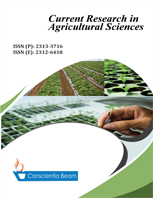Comparing Post-Partum Growth by Body Weight between Sex and Litter Size of Agouti (Dasyprocta Leporina) Offspring from Birth to 360 Days Old
DOI:
https://doi.org/10.18488/journal.68.2019.62.121.134Abstract
Thirty (30) offspring were weaned at 7 days old and 12 weights were taken every 30 days from the date of birth until 360 days old. The objectives of this study were: 1) to observe any dimorphism by live weight gain between agouti males and females at each 30 day interval, 2) to see if there was any difference in growth rate between litter sizes, and 3) to observe of there was a point where growth plateaued and to decide on an average age and weight for utilization (meat). Results suggested that: 1) Offspring can be weaned as early as 7 days, 2) Single born offspring grew faster than double or triple born initially in the earlier periods of life (< 6 months old) (18.89 g/d vs.17.61 g/d, 17.57 g/d) 3) Compensatory growth took place for offspring that came from larger litters in the latter stages of life (> 6 months old) (1.25 g/d, 1.21 g/d vs. 0.87 g/d) and had no major disadvantage by weight when compared to single born offspring (2750.8g 2770.0g and 2784.1g,), 4) Male and female offspring grew at the same rate from day 0 to 360, hence no sexual dimorphism by live weight was seen at day 360, 5) The average weight for optimum utilization (harvest) by live weight is no less than 2600g which can be achieved by 8 months of age, 6) The Gompertz growth model best describes the growth of Agouti offspring as compared to the Logistic and Von Bertalanffy models.

